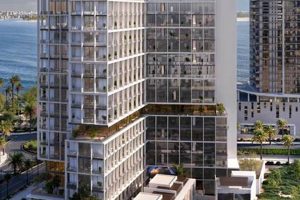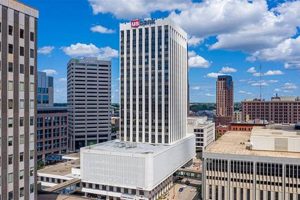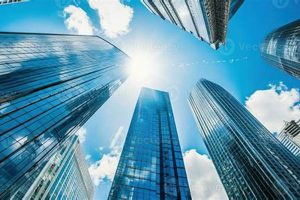Singapore’s skyline is dominated by skyscrapers, which are a testament to the city-state’s economic prosperity and architectural prowess. These towering structures house offices, apartments, hotels, and other commercial spaces, and their unique designs have become iconic landmarks.
One of the most famous skyscrapers in Singapore is the Marina Bay Sands, which is also one of the most expensive buildings ever constructed. This integrated resort features a hotel, casino, shopping mall, and convention center, and its rooftop infinity pool offers stunning views of the city skyline.
Another iconic skyscraper in Singapore is the One Raffles Place, which is the tallest building in the city. This office tower is home to many multinational corporations and financial institutions, and its distinctive shape has made it a recognizable symbol of Singapore’s business district.
Singapore’s skyscrapers are not only impressive feats of engineering but also contribute to the city’s economy and quality of life. They provide much-needed office space for businesses, and their retail and entertainment facilities attract both locals and tourists. In addition, the city’s strict building codes ensure that skyscrapers are safe and environmentally friendly.
1. Height
The height of Singapore’s skyscrapers is a defining characteristic that sets them apart from buildings in other cities around the world. Several factors have contributed to the development of tall buildings in Singapore, including the city-state’s limited land area, its strong economy, and its ambitious urban planning vision.
- Land scarcity: Singapore is a small island nation with a limited amount of land available for development. As a result, building upwards has been a necessary strategy to accommodate the city’s growing population and businesses.
- Economic growth: Singapore’s strong economy has fueled the construction of skyscrapers, as businesses seek to establish a presence in the city’s central business district and cater to the growing demand for office space.
- Urban planning: The Singapore government has played a significant role in promoting the development of tall buildings through its urban planning policies. The government has designated certain areas of the city as “skyscraper zones” and has provided incentives for developers to build tall buildings.
The height of Singapore’s skyscrapers has had a number of positive impacts on the city. Tall buildings provide much-needed office space for businesses, and they can also help to create a more vibrant and dynamic urban environment. In addition, tall buildings can serve as landmarks and tourist attractions, helping to boost the city’s economy and global profile.
2. Architecture
The architecture of Singapore’s skyscrapers is a key component of what makes them so iconic and recognizable. The city’s skyscrapers are known for their innovative and daring designs, which often incorporate elements of local culture and tradition. For example, the Esplanade Theatres on the Bay are designed to resemble the durian fruit, a popular local fruit. The Marina Bay Sands is another iconic skyscraper with a unique design, featuring three towers connected by a rooftop infinity pool.
The innovative architecture of Singapore’s skyscrapers has helped to make the city a global destination for architecture enthusiasts and tourists. The city’s skyscrapers have also been recognized for their sustainability and environmental friendliness. Many of the city’s skyscrapers have achieved Green Mark Platinum certification, which is the highest level of environmental certification in Singapore. The focus on sustainability in the design of Singapore’s skyscrapers is a reflection of the city’s commitment to environmental protection and sustainable development.
The architecture of Singapore’s skyscrapers is a key part of what makes the city unique and vibrant. The city’s skyscrapers are not only impressive feats of engineering, but they are also works of art that reflect the city’s culture and values.
3. Sustainability
Sustainability is a key consideration in the design and construction of Singapore’s skyscrapers. The city-state has set a goal of becoming a zero-carbon nation by 2050, and its skyscrapers are playing a major role in achieving this goal. Many of Singapore’s skyscrapers have achieved Green Mark Platinum certification, which is the highest level of environmental certification in Singapore. This certification is awarded to buildings that meet stringent environmental standards, including energy efficiency, water conservation, and waste management.
There are a number of reasons why sustainability is so important in the design of Singapore’s skyscrapers. First, Singapore is a small island nation with limited natural resources. As a result, the city-state needs to be efficient in its use of energy and water. Second, Singapore is located in a tropical climate, which means that its buildings need to be designed to withstand extreme heat and humidity. Finally, Singapore is a global city that attracts businesses and tourists from all over the world. The city-state wants to be seen as a leader in sustainability, and its skyscrapers are a key part of that image.
There are a number of ways that Singapore’s skyscrapers are designed to be sustainable. For example, many of the city’s skyscrapers use energy-efficient lighting and appliances. They also have green roofs and walls, which help to reduce heat gain and improve air quality. In addition, many of Singapore’s skyscrapers are equipped with rainwater harvesting systems, which collect rainwater for use in irrigation and other non-potable purposes.
The sustainability of Singapore’s skyscrapers is not only good for the environment, but it is also good for business. Green buildings are more cost-efficient to operate than traditional buildings, and they can attract tenants who are looking for sustainable workplaces. In addition, Singapore’s commitment to sustainability has helped to attract international investment and recognition.
4. Mixed-use
Mixed-use skyscrapers are a common sight in Singapore, where land is scarce and space is at a premium. These buildings combine residential, commercial, and retail space in a single structure, creating a vibrant and convenient living environment. There are many benefits to living in a mixed-use skyscraper, including reduced commuting times, easy access to amenities, and
a sense of community.
- Convenience: Mixed-use skyscrapers offer a high level of convenience for residents. With residential, commercial, and retail space all under one roof, residents can easily access everything they need without having to leave the building. This is especially beneficial for busy professionals and families with young children.
- Reduced commuting times: Mixed-use skyscrapers can help to reduce commuting times for residents. By living and working in the same building, residents can avoid the daily commute to and from work. This can save residents a significant amount of time and money each year.
- Sense of community: Mixed-use skyscrapers can help to foster a sense of community among residents. By living and working in the same building, residents are more likely to interact with each other and build relationships. This can lead to a more vibrant and social living environment.
Mixed-use skyscrapers are an important part of Singapore’s urban landscape. They offer a number of benefits for residents, including convenience, reduced commuting times, and a sense of community. As Singapore continues to grow and develop, mixed-use skyscrapers are likely to become even more common.
5. Public spaces
Singapore’s skyscrapers are not just impressive feats of engineering, but they also play an important role in creating a vibrant and livable city. One of the key ways that skyscrapers do this is by incorporating public spaces into their design. These public spaces can take many forms, such as parks, gardens, plazas, and sky gardens. They provide a place for people to relax, socialize, and enjoy the outdoors, and they can also help to improve air quality and reduce the urban heat island effect.
There are many benefits to incorporating public spaces into the design of skyscrapers. For one, it can help to create a more sustainable and environmentally friendly city. Green spaces can help to reduce air pollution and improve air quality, and they can also help to reduce the urban heat island effect. In addition, public spaces can provide a place for people to exercise and socialize, which can lead to improved physical and mental health.
Another benefit of incorporating public spaces into the design of skyscrapers is that it can help to create a more vibrant and livable city. Public spaces can provide a place for people to meet and socialize, and they can also host events and activities that can bring the community together. In addition, public spaces can help to create a more sense of place and identity for a city.
There are many examples of skyscrapers in Singapore that incorporate public spaces into their design. One example is the Marina Bay Sands, which has a large rooftop garden that is open to the public. Another example is the One Raffles Place, which has a public plaza that is used for events and activities. These are just a few examples of the many ways that skyscrapers in Singapore are incorporating public spaces into their design.
The incorporation of public spaces into the design of skyscrapers is an important trend that is helping to create a more sustainable, livable, and vibrant city. As Singapore continues to grow and develop, it is likely that we will see even more skyscrapers incorporating public spaces into their design.
6. Landmark
Singapore’s skyscrapers are more than just tall buildings; they are iconic landmarks that have become synonymous with the city. The Merlion statue at Marina Bay is just one example of how skyscrapers have become a defining feature of Singapore’s skyline and identity.
There are a number of reasons why Singapore’s skyscrapers have become such iconic landmarks. First, they are simply very tall and impressive structures. The One Raffles Place, for example, is the tallest building in Singapore at 282 meters tall. This height makes Singapore’s skyscrapers visible from all over the city, and they have become a recognizable symbol of Singapore’s economic prosperity and ambition.
Second, Singapore’s skyscrapers are often designed with unique and innovative architecture. The Marina Bay Sands, for example, is known for its three towers that are connected by a rooftop infinity pool. This unique design has made the Marina Bay Sands one of the most photographed buildings in the world.
Third, Singapore’s skyscrapers are often located in prime locations. The One Raffles Place, for example, is located in the heart of Singapore’s financial district. This location makes it a convenient and prestigious place to do business, and it has helped to make Singapore a major financial center in Asia.
The iconic status of Singapore’s skyscrapers has a number of practical benefits for the city. First, it helps to attract tourists. The Merlion statue at Marina Bay, for example, is a popular tourist destination, and it helps to draw visitors from all over the world to Singapore. Second, it helps to boost the city’s economy. The One Raffles Place, for example, is home to many multinational corporations, and it helps to attract investment to Singapore. Third, it helps to create a sense of identity and pride for Singaporeans. Singapore’s skyscrapers are a symbol of the city’s progress and ambition, and they help to create a sense of place for Singaporeans.
In conclusion, Singapore’s skyscrapers are iconic landmarks that have become synonymous with the city. They are tall, impressive structures that are often designed with unique and innovative architecture. They are also located in prime locations, which helps to attract tourists, boost the economy, and create a sense of identity and pride for Singaporeans.
7. Economic impact
Singapore’s skyscrapers play a major role in the city’s economy. They provide much-needed office space for businesses, and they also attract tourists from all over the world. This economic impact is a key component of what makes Singapore skyscrapers so important.
One of the most important ways that skyscrapers contribute to Singapore’s economy is by providing office space for businesses. Singapore is a major financial and business center, and its skyscrapers provide the necessary space for these businesses to operate. The One Raffles Place, for example, is one of the tallest buildings in Singapore and is home to many multinational corporations. These businesses provide jobs for Singaporeans and contribute to the city’s economy.
In addition to providing office space, Singapore’s skyscrapers also attract tourists. The Marina Bay Sands, for example, is one of the most iconic buildings in Singapore and is a popular tourist destination. Tourists come from all over the world to see the Marina Bay Sands and other skyscrapers in Singapore. This tourism industry generates revenue for the city and helps to support the local economy.
The economic impact of Singapore’s skyscrapers is significant. They provide much-needed office space for businesses, and they also attract tourists from all over the world. This economic impact is a key component of what makes Singapore skyscrapers so important.
Singapore Skyscraper FAQs
This section provides answers to frequently asked questions about Singapore’s skyscrapers.
Question 1: What is the tallest skyscraper in Singapore?
Answer: The tallest skyscraper in Singapore is the One Raffles Place, which stands at 282 meters tall.
Question 2: How many skyscrapers are there in Singapore?
Answer: There are over 500 skyscrapers in Singapore.
Question 3: What is the most iconic skyscraper in Singapore?
Answer: The most iconic skyscraper in Singapore is the Marina Bay Sands, which is known for its three towers that are connected by a rooftop infinity pool.
Question 4: Are Singapore’s skyscrapers sustainable?
Answer: Yes, many of Singapore’s skyscrapers are designed to be sustainable and environmentally friendly. Many of them have achieved Green Mark Platinum certification, which is the highest level of environmental certification in Singapore.
Question 5: What is the economic impact of Singapore’s skyscrapers?
Answer: Singapore’s skyscrapers play a major role in the city’s economy. They provide much-needed office space for businesses, and they also attract tourists from all over the world.
Question 6: What is the future of Singapore’s skyscrapers?
Answer: The future of Singapore’s skyscrapers is bright. The city-state is committed to sustainable development, and its skyscrapers will continue to play a major role in the city’s economy and skyline.
These are just a few of the most frequently asked questions about Singapore’s skyscrapers. If you have any other questions, please feel free to contact us.
Thank you for your interest in Singapore’s skyscrapers.
Transition to the next article section:
Singapore’s skyscrapers are a major part of the city’s identity and culture. They are a symbol of the city’s economic prosperity and ambition, and they play a major role in the city’s economy and skyline.
Tips for Visiting Singapore’s Skyscrapers
Singapore’s skyscrapers are a must-see for any visitor to the city. Here are a few tips to help you make the most of your visit:
Tip 1: Do your research. Before you visit any of Singapore’s skyscrapers, be sure to do your research and learn about the different buildings. This will help you to choose the ones that you are most interested in visiting and to plan your itinerary accordingly.
Tip 2: Book your tickets in advance. Many of Singapore’s skyscrapers offer timed tickets, so it is a good idea to book your tickets in advance, especially if you are visiting during peak season.
Tip 3: Arrive early. Give yourself plenty of time to arrive at the skyscraper, go through security, and get to the observation deck. This will help you to avoid missing your timed ticket or having to wait in long lines.
Tip 4: Dress appropriately. Many of Singapore’s skyscrapers have dress codes, so be sure to dress appropriately when you visit. This means avoiding shorts, flip-flops, and other casual clothing.
Tip 5: Bring your camera. Don’t forget to bring your camera so that you can capture the amazing views from the observation decks.
Tip 6: Enjoy the experience. Take your time to enjoy the views and the experience of visiting Singapore’s skyscrapers. These buildings are truly amazing, and they offer a unique perspective on the city.
Summary of key takeaways or benefits:
- By following these tips, you can make the most of your visit to Singapore’s skyscrapers.
- These buildings offer amazing views of the city and are a must-see for any visitor.
- Be sure to do your research, book your tickets in advance, and arrive early to avoid any hassles.
Transition to the article’s conclusion:
Singapore’s skyscrapers are an iconic part of the city skyline and a must-see for any visitor. By following these tips, you can make the most of your visit and enjoy the amazing views that these buildings have to offer.
Singapore Skyscrapers
Singapore’s skyscrapers are a testament to the city-state’s economic prosperity and architectural prowess. These towering structures house offices, apartments, hotels, and other commercial spaces, and their unique designs have become iconic landmarks. Singapore’s commitment to sustainability is reflected in the design of its skyscrapers, many of which have achieved Green Mark Platinum certification. The city’s skyscrapers also play a major role in the economy, providing much-needed office space for businesses and attracting tourists from all over the world.
The future of Singapore’s skyscrapers is bright. The city-state is committed to sustainable development, and its skyscrapers will continue to play a major role in the city’s economy and skyline. Singapore’s skyscrapers are a symbol of the city’s progress and ambition, and they are a must-see for any visitor to the city.







